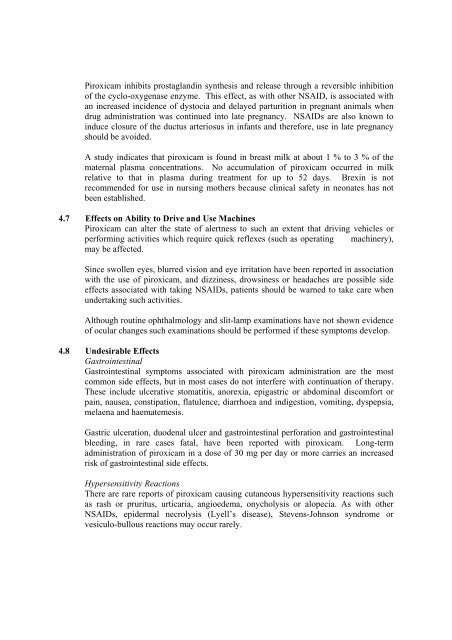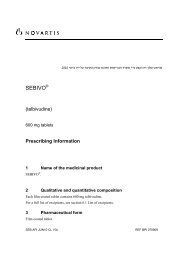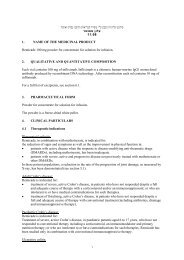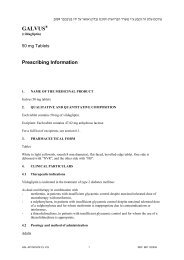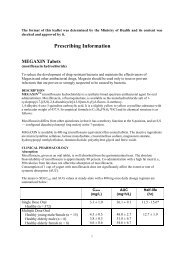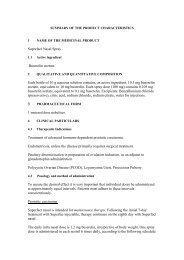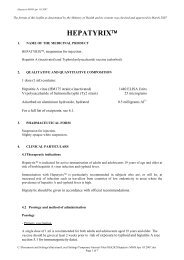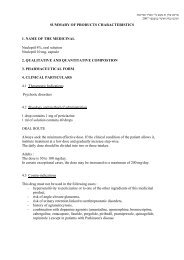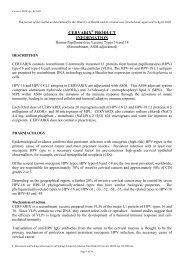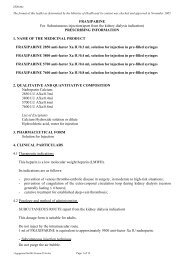BREXIN
BREXIN
BREXIN
You also want an ePaper? Increase the reach of your titles
YUMPU automatically turns print PDFs into web optimized ePapers that Google loves.
Piroxicam inhibits prostaglandin synthesis and release through a reversible inhibition<br />
of the cyclo-oxygenase enzyme. This effect, as with other NSAID, is associated with<br />
an increased incidence of dystocia and delayed parturition in pregnant animals when<br />
drug administration was continued into late pregnancy. NSAIDs are also known to<br />
induce closure of the ductus arteriosus in infants and therefore, use in late pregnancy<br />
should be avoided.<br />
A study indicates that piroxicam is found in breast milk at about 1 % to 3 % of the<br />
maternal plasma concentrations. No accumulation of piroxicam occurred in milk<br />
relative to that in plasma during treatment for up to 52 days. Brexin is not<br />
recommended for use in nursing mothers because clinical safety in neonates has not<br />
been established.<br />
4.7 Effects on Ability to Drive and Use Machines<br />
Piroxicam can alter the state of alertness to such an extent that driving vehicles or<br />
performing activities which require quick reflexes (such as operating machinery),<br />
may be affected.<br />
Since swollen eyes, blurred vision and eye irritation have been reported in association<br />
with the use of piroxicam, and dizziness, drowsiness or headaches are possible side<br />
effects associated with taking NSAIDs, patients should be warned to take care when<br />
undertaking such activities.<br />
Although routine ophthalmology and slit-lamp examinations have not shown evidence<br />
of ocular changes such examinations should be performed if these symptoms develop.<br />
4.8 Undesirable Effects<br />
Gastrointestinal<br />
Gastrointestinal symptoms associated with piroxicam administration are the most<br />
common side effects, but in most cases do not interfere with continuation of therapy.<br />
These include ulcerative stomatitis, anorexia, epigastric or abdominal discomfort or<br />
pain, nausea, constipation, flatulence, diarrhoea and indigestion, vomiting, dyspepsia,<br />
melaena and haematemesis.<br />
Gastric ulceration, duodenal ulcer and gastrointestinal perforation and gastrointestinal<br />
bleeding, in rare cases fatal, have been reported with piroxicam. Long-term<br />
administration of piroxicam in a dose of 30 mg per day or more carries an increased<br />
risk of gastrointestinal side effects.<br />
Hypersensitivity Reactions<br />
There are rare reports of piroxicam causing cutaneous hypersensitivity reactions such<br />
as rash or pruritus, urticaria, angioedema, onycholysis or alopecia. As with other<br />
NSAIDs, epidermal necrolysis (Lyell’s disease), Stevens-Johnson syndrome or<br />
vesiculo-bullous reactions may occur rarely.


